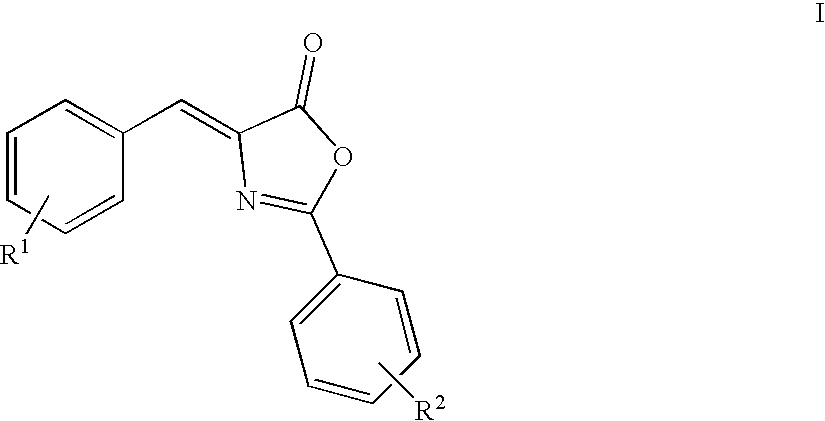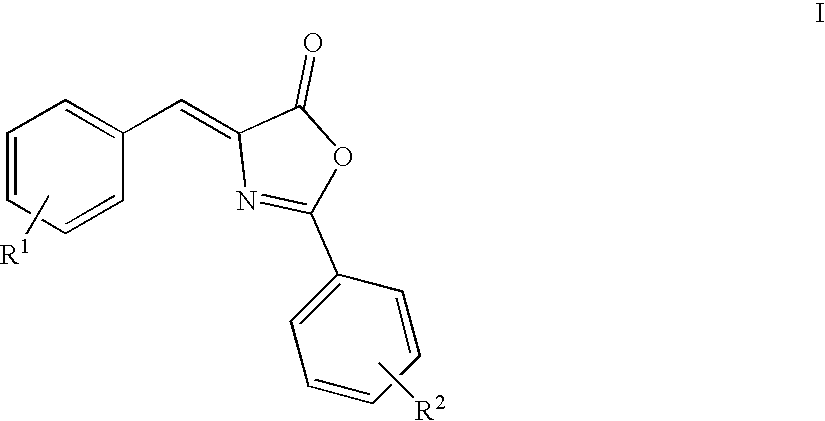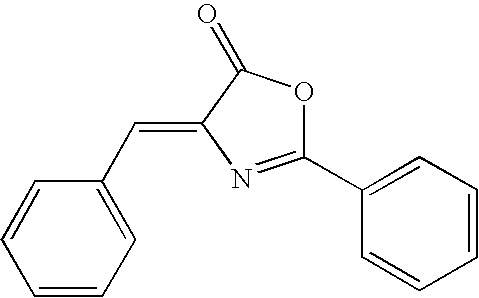Oxazolone analogs as amyloid aggregation inhibitors and for the treatment of alzheimer's disease and disorders related to amyloidosis
an amyloid aggregation inhibitor and amyloid aggregation technology, applied in the field of amyloid aggregation inhibitors of oxazolone analogs, can solve the problems of inability to directly image amyloid deposits in vivo, difficult to achieve direct amyloid deposits imaging, and the failure of attempts to image amyloid deposits directly using magnetic resonance imaging and computer-aided tomography
- Summary
- Abstract
- Description
- Claims
- Application Information
AI Technical Summary
Benefits of technology
Problems solved by technology
Method used
Image
Examples
example 2
[0139] Preparation of 4-(3,4-Dimethoxy-benzylidene)-2-phenyl-4H-oxazol-5-o-ne
[0140] A mixture of 3,4-dimethylbenzaldehyde (1.66 g, 0.10 mol), hippuric acid (1.97 g, 0.11 mol), sodium acetate (0.84 g, 0.102 mol), and acetic anhydride (2.83 mL) was heated to reflux for 3 hours (110.degree. C.). After cooling to room temperature, the precipitate was triturated with ethanol and washed with water, and then dried under vacuum to give the product as a yellow solid, 1.12 g (0.003 mol, 36%); mp 146-148.degree. C.
[0141] Analysis of C.sub.18H.sub.15NO.sub.4.0.25 mol H.sub.2O: C, 68.89; H, 4.98; N, 4.46. Found: C, 68.88; H, 4.85; N, 4.38.
example 3
[0142] Preparation of 4-(4-Dimethylamino-naphthalen-1-ylmethylene)-2-pheny-l-4H-oxazol-5-one
[0143] A mixture of 4-dimethylamino-1-napthaldehyde (1.04 g, 0.005 mol), hippuric acid (1.03 g, 0.0057 mol), sodium acetate (0.44 g, 0.0053 mol), and acetic anhydride (1.47 mL) was heated to reflux for 4 hours (110.degree. C.). After cooling to room temperature, the precipitate was triturated with ethanol, washed with water, and then dried under vacuum. The crude solid was purified via MPLC (10% EtOAc / hexanes) to give the product as a red / brown solid, 100 mg (0.178 mol, 15.9%); mp 103-106.degree. C.
[0144] Analysis of C.sub.22H.sub.18N.sub.2O.sub.2.0.5 mol ethyl acetate: Calcd: C, 74.59; H, 5.74; N, 7.25. Found: C, 73.66; H, 5.83; N, 7.33.
example 4
[0145] Preparation of 4-(3,5-Dichloro-2-hydroxy-benzylidene)-2-phenyl-4H-o-xazol-5-one
[0146] A mixture of 3,5-dichlorosalicylaldehyde (5.0 g, 0.026 mol), hippuric acid (5.16 g, 0.029 mol), sodium acetate (2.19 g, 0.0267 mol) and acetic anhydride (1.47 mL) was heated to reflux for 4 hours (110.degree. C.). After cooling to room temperature, the precipitate was triturated with ethanol, washed with water, and then dried under vacuum. The crude solid was purified via MPLC (10% EtOAc / hexanes) to give the product as a red / brown solid, 100 mg (0.178 mol, 15.9%); mp 210-212.degree. C.
[0147] Analysis of C.sub.16H.sub.9NO.sub.3Cl.sub.2.0.14 mol H.sub.2O.0.44 mol ethyl acetate: Calcd: C, 56.82; H, 3.44; N, 3.73. Found: C, 56.75; H, 3.52; N, 3.51.
PUM
| Property | Measurement | Unit |
|---|---|---|
| Pharmaceutically acceptable | aaaaa | aaaaa |
| Aggregation | aaaaa | aaaaa |
Abstract
Description
Claims
Application Information
 Login to View More
Login to View More - R&D
- Intellectual Property
- Life Sciences
- Materials
- Tech Scout
- Unparalleled Data Quality
- Higher Quality Content
- 60% Fewer Hallucinations
Browse by: Latest US Patents, China's latest patents, Technical Efficacy Thesaurus, Application Domain, Technology Topic, Popular Technical Reports.
© 2025 PatSnap. All rights reserved.Legal|Privacy policy|Modern Slavery Act Transparency Statement|Sitemap|About US| Contact US: help@patsnap.com



